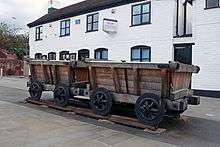Gloucester and Cheltenham Tramroad

The Gloucester and Cheltenham Tramroad, also known as the Gloucester and Cheltenham Railway, connected Gloucester and Cheltenham with horse-drawn trams. Its primary economic purpose was the transport of coal from Gloucester's (then new) docks to the rapidly developing spa town of Cheltenham, and onwards to the Cotswolds. It also linked with a route from quarries on nearby Leckhampton Hill, aiding considerably in bringing Cotswold stone down to central Cheltenham, where it was desirable as a building material, and carried other freight and passengers.
History
Construction began in 1809, and the official opening took place on 4 June 1811. A series of experiments were undertaken with using steam power on the line, though these are believed to be abortive, with no full journeys completed. The majority of the line was closed in 1861, however the link to Leckhampton's quarries and its system of inclined planes (the steepest of which rose 210 feet (64 m) at an average gradient of 1 in 2.1 or 47.6 %) continued to operate until 1922. The quarry continued until an accident involving a Fiat lorry prompted its closure in 1927 for safety reasons.
Like many other primitive tram roads – or plateways as they are sometimes called – the Gloucester and Cheltenham Tramroad offered a smoother alternative to contemporary highways for horse-drawn waggons. It also guided plain wheeled carts by means of upright flanges on the inside edges of its metal running plates, which themselves rested on stone blocks. In the case of the Gloucester and Cheltenham Tramroad, these flanges were to be set 3 ft 6 in (1,067 mm) apart.
Route
Prior to construction several routes were considered. The route ultimately built left the docks crossing Southgate Street, around the south of the city centre and across Barton Street and Horton Road (near the current level crossing). It then turned north-east along Elmbridge Road meeting Cheltenham Road in Longlevens, the route of which it followed, along with Cheltenham Road East through Churchdown. It ran in parallel with a turnpike road past Staverton Bridge, the then Plough Inn and Arle Court. It followed what is now Gloucester Road turning left towards Cheltenham Spa railway station. At this point it split into two branches.
The first ran along Gloucester Road to the terminus depot near the junction with Tewkesbury Road. The second ran down Queen's Road to Westal Green, across Tivoli and Leckhampton (and where the Norwood pub stands) before ascending Leckhampton Hill via inclined plane to the quarries there. The Railway Inn in Leckhampton was named after the Tramroad.
References
- The Gloucester and Cheltenham Railway and the Leckhampton Quarry Tramroads. Locomotion Papers Number Forty-Three. D. E. Bick, Oakwood Press, 1968.